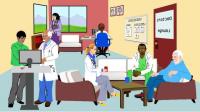You are only seeing posts authors requested be public.
Register and Login to participate in discussions with colleagues.
Health issues for adults born with cerebral palsy
Public
 What happens to children born with cerebral palsy when they become adults?
What happens to children born with cerebral palsy when they become adults?
In one case an individual born with cerebral palsy when they were an adult in their early 30’s had progressive deterioration of function involving their affected upper limb.
The individual was reviewed by their orthopedic surgeon who suggested botox injections for spasms and possibly some cosmetic improvement to the upper extremity although not optimistic for functional improvement.
The case was also reviewed with a neurologist who suggested neurological consultation with EMG studies and MRI studies, if needed, focused on any findings suggesting disc herniation, plexus lesion or other impingement.
Following neurological assessment the individual proceeded to selective botox injections for the spasms hoping the reduced spasms would permit more movement and possibly even the chance to return to the piano for exercise. In this case, after observing results of the botox injections tendon transfer surgery was undertaken.
General advice for adults living with cerebral palsy.
Here are some good web links to resources and discussions for adults born with cerebral palsy.
http://www.ninds.nih.gov/disorders/cerebral_palsy/detail_cerebral_palsy.htm
http://www.cerebralpalsysource.com/About_CP/adults_cp/index.html
http://www.jik.com/awcp.html
http://www.publicaffairs.ubc.ca/2009/10/01/grad-student-tackles-cerebral...
The last of these links describes the findings of Marylyn Horsman, a master’s student in UBC’s Rehabilitation Sciences. http://www.publicaffairs.ubc.ca/2009/10/01/grad-student-tackles-cerebral...
Marylyn Horsman shares some interesting findings and insight as a non-physician. She was surprised to find most studies on cerebral palsy she came across ended when individuals reached 18 years. “Once you become an adult with cerebral palsy, you fall through the cracks ... People don’t often think about the extra energy it takes to live with a disability, and the stresses that creates on the body … the secondary conditions associated with cerebral palsy,” she says. “For instance, doctors wouldn’t necessarily say fatigue or certain types of pain are related to a patient’s chronic disorder, and it is vital to recognize this when looking at different treatment programs.”
In a conversation with Marylyn Horsman we discussed, among other things, how exercise might help a person's functional ability and possibly avoid or delay the need for some surgical procedures. When asked what kind of exercise she referred to the Feldenkrais method.
I was not surprised to hear her esteem for the Feldenkrais method. Having had some direct but limited experience with the Feldenkrais method in the past I know it to be a very different approach especially when the exercises are done listening to recordings of Moshe Feldenkrais guiding the listener through the exercise step by step.
With his guidance the movements in the exercises are just small movements that are repeated and involve working with only one side of the body in any one session.
Individual therapists, including those with training in the Feldenkrais Method, may use variations of techniques in the way they combine their knowledge and experience.
No matter who you are, for sure take a listen if you can to a recording of Moshe Feldenkrais guiding an exercise lesson and if you can follow along do the exercise just to experience it.
Moshe Feldenkrais also authored several books. In the book "Awareness through movement" Moshe Feldenkrais describes his movement lessons. In another book, "The case of Nora" he describes working with a person who suffered a stroke with resulting hemiplegia, one sided paralysis, and experienced recovery of function. It is hard to know to what extent the method was responsible but Feldenkrais ponders if the approach of exercising just one side creates body learning that is then transferred from one side of the brain to the other.
PubMed Citations:
Horsman M, Suto M, Dudgeon B, Harris SR. Growing older with cerebral palsy: Insiders perspectives. Pediatric Physical Therapy. 2010;22:296-303.
Horsman M, Suto M, Dudgeon B, Harris SR. Aging with cerebral palsy: Psychosocial issues. Age & Ageing. 2010;39:294-299. Epub 2010 Feb 22.
Web resources:
General advice for adults living with cerebral palsy.
http://www.publicaffairs.ubc.ca/2009/10/01/grad-student-tackles-cerebral...
http://www.ninds.nih.gov/disorders/cerebral_palsy/detail_cerebral_palsy.htm
http://www.cerebralpalsysource.com/About_CP/adults_cp/index.html
http://www.jik.com/awcp.html
The Feldenkrais method.
http://en.wikipedia.org/wiki/Feldenkrais_Method
Here are some podcasts by Jill Wigmore-Welsh that are freely available.
http://feldenkrais.podbean.com/
Links to recordings of Moshe Feldenkrais, available for purchase
https://www.feldenkrais.com/shop/index.php?main_page=index&cPath=257&zen...
https://www.feldenkrais.com/shop/index.php?main_page=product_info&cPath=...
https://www.feldenkrais.com/shop/index.php?main_page=product_info&cPath=...
https://www.feldenkrais.com/shop/index.php?main_page=product_info&cPath=...
https://www.feldenkrais.com/shop/index.php?main_page=product_info&cPath=...




